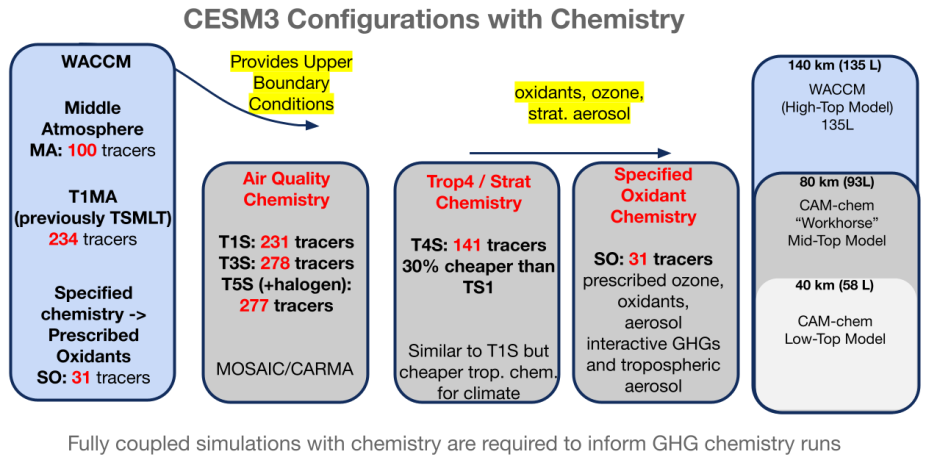Model Developments
The following developments for CAM-chem (including the Workhorse Model: Mid-Top 93L (80km) and Low-Top 58L (40km) (ne30pg3)) are listed below.
Detailed development plans: Wiki Page
Updates planned for CESM3:
- Default configuration will be Spectral Element dynamical core with a cubed sphere grid at approximately 1-degree resolution (ne30pg3)
- Introduction of stratospheric aerosol (MAM5)
- New dust scheme (Leung et al., 2023)
- Chemistry mechanism naming: T1S etc. -- numbers are associated with the tropospheric mechanism because this updates frequently. Workhorse chemistry (for CMIP7) will be T4S. More detail on different mechanisms here: https://www2.acom.ucar.edu/gcm/mozart
- Updated vertical resolution: more layers in the PBL and UT/LS
- Low-Top = 58 layers to ~40 km
- Mid-Top = 93 layers to ~80 km
- High Top (WACCM) = 135 layers to ~140 km

Updates implemented but not validated:
- Chemistry: Troposphere + Stratosphere (TS1.2) (CAM Issue #558)
- New aerosol model: MAM5 (MAM4 + 1 mode for stratospheric sulfate) for all CESM configuration (CAM Issue #663, #664)
- Optional Upper boundary conditions for the low top L58 model (CAM Issue #533)
- Updated Soil NOx emissions (CTSM Issue #1952)
- Simple chemistry (for CAM7) with updated SOA parameterization to support tropospheric aerosol formation (MAM4) (CAM Issue #727)
- T4 chemistry mechanism, simplified from T1 to be used for longer climate-scale simulations such as CMIP7
- Online DMS emissions based on Online Air-Sea Interface for Soluble Species (OASISS) -> all CESM compsets (CAM, CAM-chem, WACCM)
- HEMCO Emission Component (CAM Issue #560)
- New dust emission scheme in CTSM (CAM Issue #651)
Updates to be added
- Additional online ocean (acetaldehyde etc.) emissions based on OASISS
- New photolysis scheme (TUV-x) (https://github.com/NCAR/tuv-x)
- Marine Organic Aerosol Emissions (CAM Issue #531)
- MEGAN3 biogenic emissions (CTSM Issue #1323)
- Very Short Lived (VSL) halogen chemistry and interactive methane emissions
Page last updated: July 2025